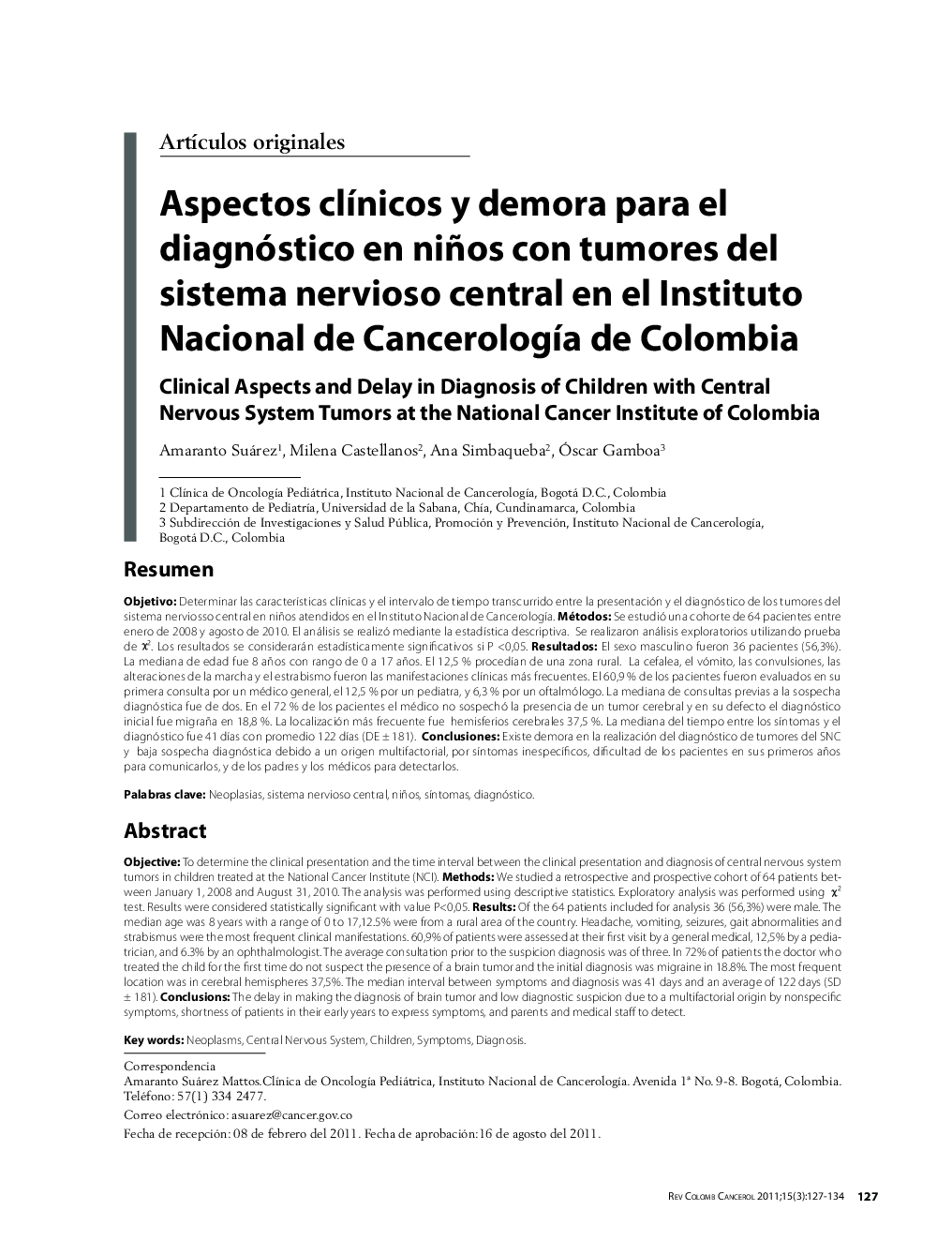| Article ID | Journal | Published Year | Pages | File Type |
|---|---|---|---|---|
| 3997220 | Revista Colombiana de Cancerología | 2011 | 8 Pages |
ResumenObjetivoDeterminar las caracterÃsticas clÃnicas y el intervalo de tiempo transcurrido entre la presentación y el diagnóstico de los tumores del sistema nerviosso central en niños atendidos en el Instituto Nacional de CancerologÃa.MétodosSe estudió una cohorte de 64 pacientes entre enero de 2008 y agosto de 2010. El análisis se realizó mediante la estadÃstica descriptiva. Se realizaron análisis exploratorios utilizando prueba de Ï2. Los resultados se considerarán estadÃsticamente significativos si P < 0,05.ResultadosEl sexo masculino fueron 36 pacientes (56,3%). La mediana de edad fue 8 años con rango de 0 a 17 años. El 12,5 % procedÃan de una zona rural. La cefalea, el vómito, las convulsiones, las alteraciones de la marcha y el estrabismo fueron las manifestaciones clÃnicas más frecuentes. El 60,9 % de los pacientes fueron evaluados en su primera consulta por un médico general, el 12,5 % por un pediatra, y 6,3 % por un oftalmólogo. La mediana de consultas previas a la sospecha diagnóstica fue de dos. En el 72 % de los pacientes el médico no sospechó la presencia de un tumor cerebral y en su defecto el diagnóstico inicial fue migraña en 18,8 %. La localización más frecuente fue hemisferios cerebrales 37,5 %. La mediana del tiempo entre los sÃntomas y el diagnóstico fue 41 dÃas con promedio 122 dÃas (DE ± 181).ConclusionesExiste demora en la realización del diagnóstico de tumores del SNC y baja sospecha diagnóstica debido a un origen multifactorial, por sÃntomas inespecÃficos, dificultad de los pacientes en sus primeros años para comunicarlos, y de los padres y los médicos para detectarlos.
ObjectiveTo determine the clinical presentation and the time interval between the clinical presentation and diagnosis of central nervous system tumors in children treated at the National Cancer Institute (NCI).MethodsWe studied a retrospective and prospective cohort of 64 patients between January 1, 2008 and August 31, 2010. The analysis was performed using descriptive statistics. Exploratory analysis was performed using Ï2 test. Results were considered statistically significant with value P < 0,05.ResultsOf the 64 patients included for analysis 36 (56,3%) were male. The median age was 8 years with a range of 0 to 17,12.5% were from a rural area of the country. Headache, vomiting, seizures, gait abnormalities and strabismus were the most frequent clinical manifestations. 60,9% of patients were assessed at their first visit by a general medical, 12,5% by a pediatrician, and 6.3% by an ophthalmologist. The average consultation prior to the suspicion diagnosis was of three. In 72% of patients the doctor who treated the child for the first time do not suspect the presence of a brain tumor and the initial diagnosis was migraine in 18.8%. The most frequent location was in cerebral hemispheres 37,5%. The median interval between symptoms and diagnosis was 41 days and an average of 122 days (SD ± 181).ConclusionsThe delay in making the diagnosis of brain tumor and low diagnostic suspicion due to a multifactorial origin by nonspecific symptoms, shortness of patients in their early years to express symptoms, and parents and medical staff to detect.
